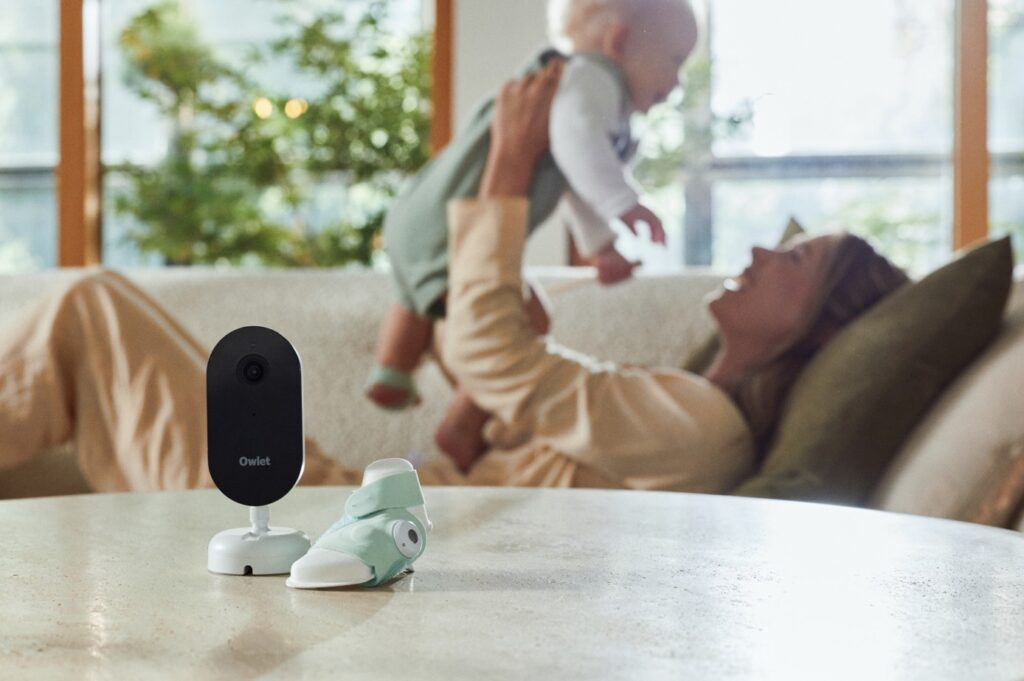Owlet’s top marketer discusses marketing a new product during a promotional season and what the baby monitor brand learned when it shut off Google search ads.
Mass marketing is not the growth plan for baby monitor brand Owlet.
The baby camera and medical sock manufacturer has a limited target audience of first-time parents, who are only looking to purchase the product once during a nine-month window.
That means Owlet’s marketing efforts have to be extremely targeted, said Liz Teran, Chief Parent Officer and former Chief Marketing Officer.
“It’s a very costly acquisition model to constantly have new people joining your targets and then leaving again,” Teran said. “It means you have to be really creative with your marketing spend and some of the mass marketing opportunities aren’t as efficient for us.”
Linear and connected TV, for example, are too broad. Instead, Owlet spends its marketing dollars where it knows expectant parents are researching and looking for advice, including social media, Reddit, influencers and blogs, Teran said. For example, Owlet wants to intercept consumers when they are reading “The 10 best baby monitors” on Wirecutter, or when their favorite content creator just announced she is pregnant, and have the right message for that shopper then, Teran said.
“We have found channels like paid social to be so much more impactful for us in the algorithms being able to find the right people, serve it up at the right time and really push them through the funnel for us,” she said.
Even though roughly 15-20% of Owlet’s sales are gifts, the parent is always the target audience, she said, as the friend or grandparent is likely buying the camera because the parent has it on the registry.
More Marketing Nuances for Owlet
Owlet has learned the hard way that word of mouth can sustain its brand and that Google search may not be as vital as it once thought.
“A couple of years ago, prior to us having our FDA clearance, we found ourselves in a tricky situation as a business where we were spending way too much money and not bringing enough in,” Teran said. “It put the business in quite a precarious position.”
In 2021, the FDA sent Owlet a warning letter declaring the brand had to take its sock product off the market because the product has medical device functionality — it monitors a baby’s pulse and oxygen levels — but the FDA had yet to approve it. Owlet had to shift gears to its more sleep-focused product and remove the product that was responsible for the majority of its revenue while it worked toward FDA clearance.
The brand, however, was still spending marketing dollars like it had the sales of its bestseller. This put Owlet in a tough spot, and by 2023 it had to cut its staff and marketing spend by 80% in order to survive, she said. That entailed turning off marketing channels including Google search ads. And while Owlet thought sales would completely flat line, they didn’t.
“When we literally didn’t have any more money, we had to turn it off,” Teran said. “We saw about an overall 10% drop in traffic, which feels significant, but our purchases didn’t shift at all.”
And that made Owlet evaluate which of its marketing spend was incremental versus paying to acquire a sale that would have already happened. Owlet’s business resumed growth once it received its FDA clearance in November 2023 and it could sell its main product. But that tough experience taught the brand to be efficient with its marketing dollars, Teran said.
“It’s been a new consistent commitment from us to keep our acquisition costs extremely efficient,” she said. “We have a blended CPA of about $19, which is great. That’s where we want to stay.”
Owlet’s Upgraded Camera
These are the lessons Owlet has to keep in mind now as it markets an upgraded version of its baby camera. The brand is mostly known for its wearable sock product, dubbed the “Dream Sock.” The brand’s video monitor was “fine but wasn’t as impressive as the sock,” Teran said. And that showed up in reviews, and how influencers talked about Owlet’s products.
“There were challenges in that product experience,” she said. “It’s not as innovative as our brand is generally known to be, and I wouldn’t say it was at the quality of what we were known to be. We often found it a bit of a hindrance in engaging with partners and parents.”
The upgraded camera has better video quality so customers can better see their babies. (2K pixel resolution up from 1080 pixel resolution, in both daylight and nighttime.) It also has better connectivity with Wi-Fi and Bluetooth, and a simpler set up taking customers “minutes” compared with roughly 20 minutes previously. Because of low engagement metrics with certain features of its old camera, Owlet made those features more obvious and easy for consumers to find within the app, plus marketed them better. What’s more, the enhanced camera is $99, which is a lower price point than its previous camera at $159.
Marketing the New Camera
Owlet launched the camera in September, timing it with its website redesign. The brand improved how it was “storytelling” about its brand and product, aiming to position itself as a leader in baby cameras. Now that the camera has these enhancements, “Owlet can proudly stand behind it,” which comes through in the content, she said.
“Because most parents think of us as the dream sock, how we established ourselves in offering a video solution was important,” Teran said. “We redesigned the entire website to tell that story better.”
The brand sells its products at many major retailers, including Target, Walmart and Best Buy, and it refreshed its point of purchase displays at the stores to showcase the camera’s features.
Owlet is using influencers to market the camera, and its better quality makes their content and excitement more genuine, Teran said.
Word-of-mouth from customers is another key to Owlet’s growth and marketing strategy.
“Over 50% of people that go on to purchase Outlet say they heard about us from a friend or family member and in a raving review,” she said. “That’s always a huge part of our plans is capturing some of those parent stories and experiences, resharing them and encouraging our parents to be advocates for us, as they are a huge factor in our success.”
Owlet will measure the success of its marketing efforts with the typical full-funnel KPIs including impressions, engagement rates, site visit, sell-through and star ratings.
The camera’s current star rating is at a 4.8, which is “significantly improved” from its previous model’s 4.4 rating, Teran said.
A Cheaper Camera in a Promotional Time
So far, sales are meeting the brand’s expectations. This is exciting because Owlet has an aggressive forecast to make up for the loss of revenue from the lower price point.
“Not only did we need to raise sell-through rates to meet that gap, but also just our overall growth and so far so good,” she said.
It’s a tough time a year to launch a product, because it’s right before a promotional time period, Teran said. Shoppers may be holding back on spending until they see what deals come through during Black Friday. Owlet plans to offer a promotion over Thanksgiving weekend, she said without providing specifics.
“We’re well positioned with strong reviews and a strong offering and strong discounts to perform well during those times,” she said.
For this campaign in particular, Owlet is pleased with the buzz its been able to create from a newer model of previous product.
“We’ve seen a lot of really great success in our top-of-funnel awareness and impressions and press coverage, which has been really great to see, especially for a video baby monitor where our main perspective was just on affordability and connectivity,” she said.
Having a quality camera product is important to Owlet because it provides an opportunity for a higher customer life time value. Parents may only use the infant sock for a few months, while they often use a baby camera for years. Plus, parents may purchase a new camera with every child they have, whereas they would reuse an infant sock.





